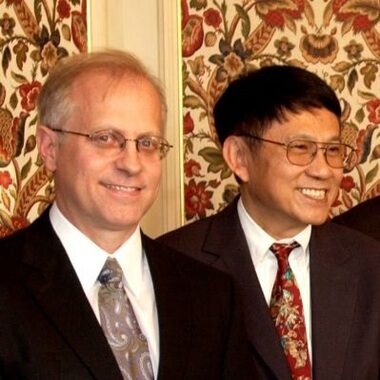Ho-kwang Mao: un profil (anglais)
États-Unis - États-Unis/Chine
Russell Hemley et Ho-kwang Mao
Prix Balzan 2005 pour la physique des minéraux
Pour le remarquable impact de leurs travaux qui ont conduit à des progrès fondamentaux, tant sur le plan théorique qu’expérimental, dans le domaine des minéraux soumis à des conditions physiques extrêmes. Formant un groupe de travail extrêmement efficace, Russell Hemley et Ho-kwang Mao ont contribué pendant vingt ans à la recherché au plus haut niveau. Ils ont mis au point des techniques permettant d’étudier le comportement d’une vaste gamme de matériaux, parmi lesquels l’hydrogène, le “minéral” le plus abondant dans l’univers. Les résultats de leurs recherches ont apporté une contribution fondamentale à notre compréhension de la nature.
Ho-kwang (Dave) Mao has been pioneering high-pressure research and applications in physics and chemistry of Earth and planetary materials. He learned mineral physics and high-pressure diamond-anvil cell technology from his thesis advisors, William A. Bassett and Taro Takahashi, and started his four-decade career in this field. With Peter Bell at Carnegie Institution, he developed diamond cells reaching multimegabar static pressure. Later with Russell J. Hemley, he improved techniques to interface diamond cells with probes such as Mössbauer, fluorescence, Raman scattering, Brillouin scattering, crystal-field, visible to far-infrared transmission and reflection spectroscopies, electrical conductivity, synchrotron x-ray diffraction and x-ray spectroscopy. With laser-heated diamond cells, Mao and colleagues reached the P-T conditions of the Earth core, and studied the physics and chemistry of materials in the Earth’s deep interior: silicates, oxides, and iron-alloys, in order to construct geophysical and geochemical models based on real data. They have also studied the high P-T properties of planetary gases and ices to better understand the giant planets and their icy satellites. He has coauthored 620 papers.
Ho-kwang Mao was born in Shanghai, China in 1941. He moved to Taiwan at age seven, grew up there, and attended the Geology Department at National Taiwan University (B.S. 1963). After one-year of military service, he went to the US in 1964 for graduate studies at the Department of Geological Sciences, University of Rochester (M.S. 1966; Ph.D. 1968). He joined the Geophysical Laboratory, Carnegie Institution of Washington in 1968, and has worked there ever since. He is the recipient of the Gregori Aminoff Prize in Crystallography (2005) from the Royal Swedish Academy of Sciences, the Roebling Medal (2005), the Mineralogical Society of America Award (1979) from the Mineralogical Society of America, the Arthur L. Day Prize, a Lectureship (1990) from the US National Academy of Science and the P. W. Bridgman Gold Medal (1989) from the International Association for the Advancement of High Pressure Science & Technology (AIRAPT). He is an elected Member of the National Academy of Science (U.S.A.), Member of the Academia Sinica (Taiwan) and Foreign Member of the Chinese Academy of Sciences (China). He has been elected a Fellow of the American Geophysical Union, the American Physical Society, the European Association for Geochemistry, the Geochemical Society, and the Mineralogical Society of America.
(September 2005)
